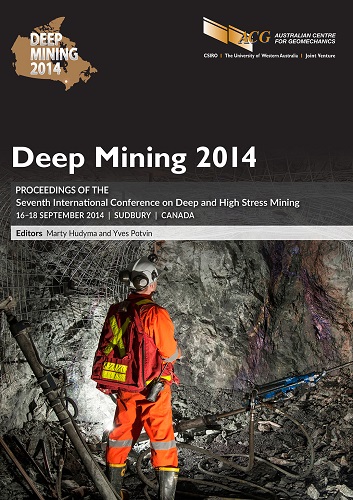Geostatistical interpolation of estimated RQD values and its use in geomechanics design considerations – a case study

|
Authors: Verma, AK; Yao, M Paper is not available for download Contact Us |
DOI https://doi.org/10.36487/ACG_rep/1410_41_Verma
Cite As:
Verma, AK & Yao, M 2014, 'Geostatistical interpolation of estimated RQD values and its use in geomechanics design considerations – a case study', in M Hudyma & Y Potvin (eds), Deep Mining 2014: Proceedings of the Seventh International Conference on Deep and High Stress Mining, Australian Centre for Geomechanics, Perth, pp. 587-600, https://doi.org/10.36487/ACG_rep/1410_41_Verma
Abstract:
Geostatistical interpolation techniques have proved its utility in all disciplines of geosciences and have potential to be used in geomechanics design applications. The principals of geostatistics are developed based on the fact that almost all geosciences data has some relationship with its location in space. Geostatistical tools decipher this relationship and exploit it to estimate the rock properties at an unsampled location. This work is an attempt to apply geostatistics in geomechanical design using nearest neighbour, inverse power and kriging interpolation of estimated Rock Quality Designation index (RQD) values from drill cores from part of one and four shear orebodies of Vale’s Garson Mine in Sudbury, Ontario, Canada. A comparative study of different methods and their correlation with mapped geology provided the most effective method for RQD interpolation. The part of orebody selected for this application has undergone intensive drilling with sufficient data volume to create an RQD block model with high degree of confidence. The RQD block model provided a basis for rock mass classification and creation of RQD maps along planned mining layouts, which served as an important tool for initial geomechanical assessment. This methodology has a potential to expand its application to other geomechanics parameters, such as RMR and Q values.
References:
Barton, NR, Lien, R & Lunde, J 1974, ‘Engineering Classification of Rock Masses for the Design of Tunnel Support’, Rock Mechanics, vol. 6, no. 4, pp. 189-239.
Bewick, RP, Valley, B, Runnalls, S, Whitney, J & Krynicki, Y 2009, ‘Global approach to managing deep mining hazards’, in M Diederichs & G Grasselli (eds), Proceedings of the 3rd CANUS Rock Mechanics Symposium: ROCKENG09, paper 3994.
Bieniawski, ZT 1989, Engineering Rock Mass Classification, John Wiley & Sons, New York.
Deere, DU, Hendron, AJ, Patton, FD & Cording, EJ 1967, ‘Design of surface and near surface construction in rock’, in C Fairhurst (ed.), Proceedings of the 8th U.S. Symposium on Rock Mechanics, American Rock Mechanics Association, Alexandria, pp. 237-302.
Isaaks, EH & Srivastava, RM 1989, An Introduction to Applied Geostatistics, chapters 7 and 12, Oxford University Press, Oxford.
Isaaks, EH & Srivastava, RM 1987, ‘Spatial continuity measures for probabilistic and deterministic geostatistics’, Proceedings of the MGUS 87 Conference, International Association for Mathematical Geology.
Kaiser, PK, Vasak, P, Suorineni, FT & Thibodeau, D 2005, ‘New dimensions in seismic data interpretation with 3-D virtual reality visualization for burst-prone mines’, in Y Potvin & Marty Hudyma (eds), Proceedings of the Sixth International Symposium on Rockburst and Seismicity in Mines, Australian Centre for Geomechanics, Perth, pp. 33-45.
Ontario Geological Survey 1996, Precambrian Geology of Garson and Blezard Township, Open File Report 5950, Ontario Geological Survey, Sudbury.
Rodolfo, MM & Reinaldo, L 2006, ‘Indicator kriging geostatistical methodology applied to geotechnics project planning’, Proceedings of the 10th IAEG International Congress, paper number 527, The Geological Society of London, London, viewed 4 August 2014,
Vatcher, J 2009, ‘Geostatistical Modeling of Geotechnical Properties at Vale Inco’s Creighton Mine, Deep Zone (Sudbury, Ontario)’, BSc thesis, Queen’s University, Kingston.
Yang, Y 2010, ‘Geostatistical Interpolation and Simulation of RQD Measurements’, MA Sc. thesis, University of British Columbia, Vancouver.
© Copyright 2026, Australian Centre for Geomechanics (ACG), The University of Western Australia. All rights reserved.
View copyright/legal information
Please direct any queries or error reports to repository-acg@uwa.edu.au
View copyright/legal information
Please direct any queries or error reports to repository-acg@uwa.edu.au